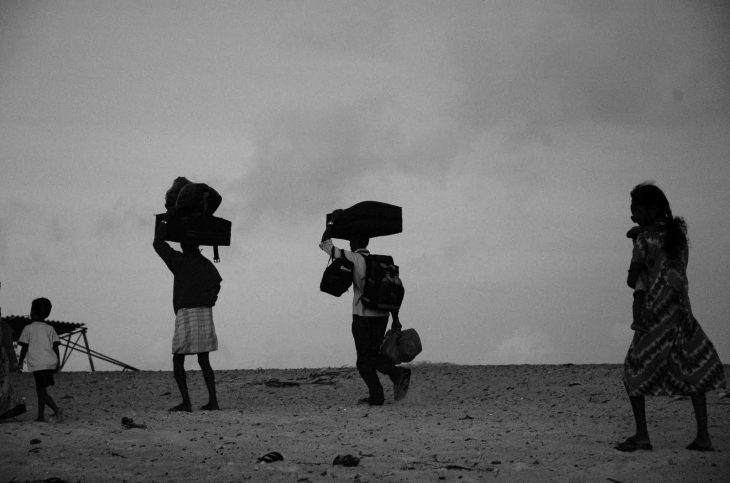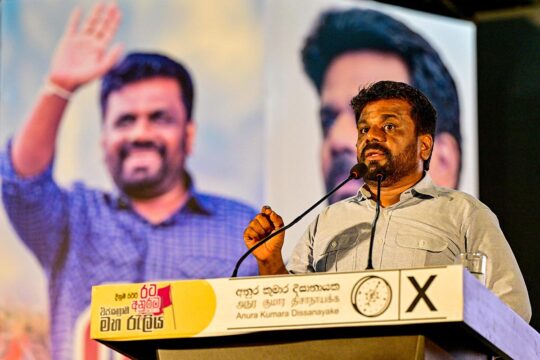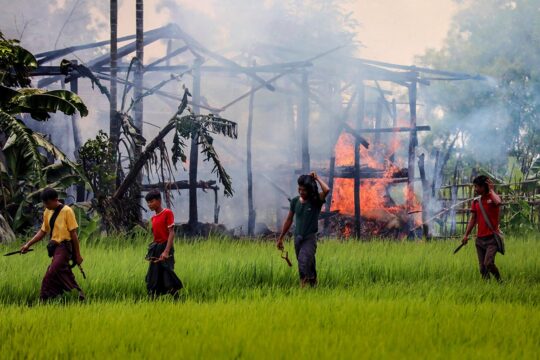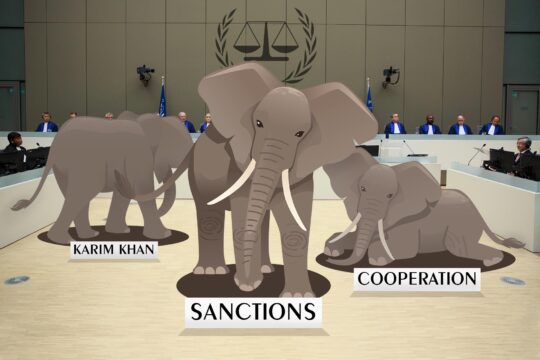Sri Lanka’s three-decade civil war in the North and East of the country, along with an insurrection in the South, witnessed the death and disappearance of thousands. Despite these egregious events, the Sri Lankan state has failed to provide public spaces for memorialisation. In this context, transitional justice practitioners in Sri Lanka have advocated for state-sponsored promotion of memorialisation. Scholars and victims are, however, divided on the issue.
This article offers an alternative perspective on the importance of ‘victim-centred’ memorialisation in Sri Lanka. It argues that memorialisation of victim experiences can help generate public demand for transitional justice. Therefore, the ‘public’ benefits of memorialisation must be appreciated in addition to its potential ‘personal’ benefits. The article is presented in three sections. The first briefly discusses a recent debate on memorialisation between Pablo de Greiff and David Rieff, and explains the importance of memorialisation to a transitional justice project. The second section discusses the diverse views of particular victim groups in Sri Lanka. It explains why some families who believe that their disappeared relatives are still alive resist the idea of memorialisation, as they see no ‘personal’ benefit in it. The final section of this article presents a case for reshaping the debate on memorialisation in Sri Lanka. It contends that memorialisation has a distinct ‘public value’, as it can ensure that a society – and not just victim groups – confronts the need for transitional justice.
The debate on memorialisation
Scholars are divided on whether memorialisation advances or impedes transitional justice and reconciliation. David Rieff, for instance, offers a pragmatic argument against remembrance. He contends: ‘historical memory is rarely as hospitable to peace and reconciliation as it is to grudge-keeping, duelling martyrologies and enduring enmity’. Similarly, in Sri Lanka ‘not dwelling on the past’ but ‘focusing on the future’ is often prescribed as the remedy that will eventually heal the wounds of conflict. Rieff’s concerns with respect to the dangers of manipulative and one-sided remembrance need to be taken seriously. Yet, as pointed out by Pablo de Greiff, such concerns do not justify a generalised antipathy towards memorialisation. He explains that the state’s duty to preserve memory is subject to a process of ‘examination, contestation, contextualisation, and verification characteristic of both historical methodologies and the work of, for example, truth commissions.’ De Greiff accordingly makes a normative case for recognising a state’s ‘duty to remember’, as it safeguards ‘accounts of the past that are sufficient to set inquiry in directions that have been previously kept hidden.’ Hence meaningful memorialisation could assist a society in the process of reckoning with its past and ensuring non-recurrence of violence.
The views of victims
Some victims remain sceptical of the value of memorialisation despite its potential to advance transitional justice. In the study, Confronting the Complexity of Loss, I invited several participants (all of whom were victims or survivors of major violent events in Sri Lanka’s recent history) to reflect on the importance of memorialising past events. It was explained that memorialising could take various forms. These forms could be ‘public’ in nature, such as monuments or special dates set aside for the purpose of remembrance, or ‘private’, such as an almsgiving. Interestingly, the participants were divided on the issue. Some victims and survivors insisted that memorialising was important – even indispensible. They contended that remembering their loss was an important feature of their personal struggle towards recovery. Others meanwhile felt that their closure depended on forgetting the past and moving on. Yet, as captured in the findings of Sri Lanka’s Consultation Task Force on Reconciliation Mechanisms (CTF), victims have generally demanded space for memorialisation as a symbolic form of reparation.
I encountered a further view on memorialisation when I recently met several families of the disappeared at an event organised in Colombo by Amnesty International. The event included a workshop on the Argentine experience on memorialisation. It aimed to help families develop strategies to compel the Sri Lankan state to provide spaces for memorialisation. Yet a number of participants expressed the view that memorialisation amounted to ‘conceding’ that their missing relatives were deceased. These participants believed that their relatives were alive; hence they rejected the idea of memorialisation altogether, and insisted that the state’s role was to ensure truth – not memory. They also expressed frustration at the lack of progress on the state’s fulfilment of its commitments to establish truth-seeking and accountability mechanisms in Sri Lanka. The attitude of these participants revealed a serious gap in Sri Lanka’s discourse on memorialisation; it was still largely conceptualised as an endeavour that can offer only ‘personal’ value (if at all) rather than ‘public’ value.
From the ‘personal’ to the ‘public’
Participants at events on memorialisation in Sri Lanka, such as the Amnesty International event, almost exclusively comprise victims, artists and activists. Victims often find themselves trapped in an ‘echo chamber’ – where their experiences do not reach broader society. This is precisely why – in addition to its normative purpose – the instrumental purpose of memorialisation must be understood. Remembering the past can have both ‘personal’ and ‘public’ value. On the one hand, it can offer victims a dignified means of maintaining the memory of lost family members. On the other, it can prompt a society to reflect on its past, and work towards the non-recurrence of violence in the future. These values are mutually reinforcing, as the state’s commitment towards transitional justice is often animated by public sentiment.
All victim groups – including families of the disappeared – must come to realise that it is the ‘public’ value in memorialisation that creates the space for truth, justice and reparations. Compelling a society to confront its past is often the most effective means of generating broader public empathy, and consequently, an acceptance of the need for transitional justice. The state’s general reluctance to deliver meaningful truth-seeking and accountability mechanisms to victims could be transformed if a broader constituency is drawn into understanding victims’ experiences. In some sense, the line between victims and the rest of society must be blurred.
An urgent need for a ‘victim-centred’ process of public memorialisation is reflected in the Sri Lankan state’s current apathy towards victim memorialisation. There are very few public monuments or memorials in Sri Lanka that commemorate victims and survivors of man-made tragedies. The capital city, Colombo – the venue of recurring violence, including the 1983 anti-Tamil pogrom, civilian bombings by the Liberation Tigers of Tamil Eelam, and countless disappearances of youth during an insurrection in the late 1980s – does not have a single monument commemorating victims and survivors of recent atrocities. By contrast, Colombo has witnessed a proliferation of monuments dedicated to the military. At least three war memorials commemorating military casualties of war exist in Colombo: a British War Memorial, a memorial for the Indian Peace Keeping Forces, and a memorial for Sri Lankan servicemen lost during the civil war. Thus the state, in defining war and post-war narratives, has rejected victim-centred memorialisation. The prescription for society appears to be clear: remember the soldiers who freed society from ‘terrorism’, not the victims and survivors who suffered in the process.
A meaningful process of memorialisation in Sri Lanka is urgently needed to challenge this state narrative, and to create and maintain space for transitional justice. Victim groups – including the families of the disappeared – must get behind such a process. They must be convinced of the value of memorialisation – if not in its ability to deliver immediate personal redress, at least in its potential to generate a transformative public conversation. Such a conversation is key to sustaining political commitment towards transitional justice in Sri Lanka.
Conclusion
When victims are prevented from remembering their experiences, the memory of a violent history may be lost, and with it, any real hope of discovering the truth or securing justice. As Phillip Lee explains: ‘The first step on the road to restitution is to resurrect or rehabilitate a people’s memory.’ While some scholars and victim groups may be sceptical about the benefits of memorialisation, there is a compelling case for recognising the ‘public’ value of memorialisation. As de Greiff points out, such memorialisation must be the work of careful examination, contestation, contextualisation, and verification. At the normative level, we must recognise the state’s duty to preserve victims’ memory. At an instrumental level, we must recognise that meaningful transitional justice is – politically speaking – difficult to achieve until Sri Lankan society collectively confronts the legacy of violent conflict. Thus an emphasis on the ‘public’ value of memorialisation is crucial, as memorialisation can be vital to generating public demand for transitional justice. It is such public demand that ultimately animates political will to deliver truth and justice for victims. As observed by the CTF, memorialisation processes must ‘strive for a sense of collective ownership.’ In the end, the face of the victim must be multi-ethnic, multi-religious and multi-cultural, so that a society, as a whole, might unite in grief.
Gehan Gunatilleke is a Research Director at Verité Research, and a Commonwealth scholar at New College, University of Oxford. He is the author of Confronting the Complexity of Loss: Perspectives on Truth, Memory and Justice in Sri Lanka (2015).






